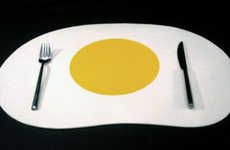
These Castey Design Awards Frying Pans Explore Efficient Futuristic Food Prep
Amelia Roblin — December 6, 2011 — Art & Design
References: industrialdesignserved
Pots and pans have changed very little in hundreds of years, but methods for cooking have adapted somewhat drastically in some places. These Castey Design Awards frying pans represent some inventive exploration of how people might begin to use culinary objects in the future, taking elementary principles like ergonomics into account.
Andres Carpinelli and his team came up with two different concepts for these next generation skillets which they have called the Lotus and the Hispana. The first seems to have the preparation of more Asian dishes in mind, while the second might be best for South American recipes.
More so than the Hispana, the Lotus assumes a rather unusual form. While it has a wok-like shape to it, it incorporates a flat bottom and silicone-covered grips around its edge that make it possible to toss sizzling veggies with ease.
Andres Carpinelli and his team came up with two different concepts for these next generation skillets which they have called the Lotus and the Hispana. The first seems to have the preparation of more Asian dishes in mind, while the second might be best for South American recipes.
More so than the Hispana, the Lotus assumes a rather unusual form. While it has a wok-like shape to it, it incorporates a flat bottom and silicone-covered grips around its edge that make it possible to toss sizzling veggies with ease.
Trend Themes
1. Innovative Cookware - Designing cookware that incorporates unique shapes and ergonomics provides opportunities for disruptive innovation in the cookware industry.
2. Cultural Adaptation in Cookware - Creating cookware that is specifically designed for different regional cooking styles offers opportunities for disrupting the cookware industry based on cultural adaptation.
3. Advanced Cooking Methodologies - Exploring advanced cooking techniques that require specialized cookware represents opportunities for disrupting the cookware industry based on advanced cooking methodologies.
Industry Implications
1. Cookware Manufacturing - Cookware manufacturers can explore innovative designs and materials to capitalize on opportunities for disruptive innovation in their industry.
2. Culinary Education - Culinary educators can incorporate innovative cookware designs into their courses, helping students stay on the forefront of emerging culinary trends.
3. Hospitality Industry - The hospitality industry can implement advanced cooking methodologies and specialized cookware to differentiate themselves from their competitors and offer unique value to customers.
3.5
Score
Popularity
Activity
Freshness























